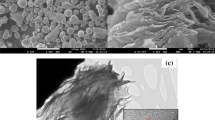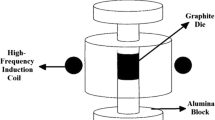Abstract
Alumina (Al2O3) has gained attention as an attractive structural ceramic material because of exceptional oxidation resistant, wear resistant and high strength under environment of high temperature. In this paper, a high-density (Up to 95%) graphene nanoplatelet (GNPs)/Al2O3 ceramic composite instead of non-conductive monolithic Al2O3 was fabricated by the spark plasma sintering method. Material properties such asrelative density, hardness and electrical conductivity of the composite with varying GNP contents (5, 10, 15, and 20 Volume Fractions) in Al2O3 were evaluated. We clearly observed fine grain size, reduced hardness, and high electrical conductivity in the composite having a GNP content of GNPs 15 vol.%. Thereafter, a micro electro discharge machining (μ-EDM) milling process was continuously performed on the GNP/Al2O3 ceramic composites for analyzing their surface roughness and surface topographyat different discharge energies. A high discharge energy lead poor surface properties such as uneven structure and the presence of cracks and pores. An increase in the surface roughness was observed at a high discharge energy and graphene contents. This study will provide valuable means into the relationship between functional materials and EDM parameters.
Similar content being viewed by others
References
Yadav, R. N. and Yadava, V., “Experimental Study of Erosion and Abrasion Based Hybrid Machining of Hybrid Metal Matrix Composite,” Int. J. Precis. Eng. Manuf., Vol. 14, No. 8, pp. 1293–1299, 2013.
Liu, J.-W., Wu, Y.-Z., and Yue, T.-M., “High Speed Abrasive Electrical Discharge Machining of Particulate Reinforced Metal Matrix Composites,” Int. J. Precis. Eng. Manuf., Vol. 16, No. 7, pp. 1399–1404, 2015.
Ramirez, C., Garzon, L., Miranzo, P., Osendi, M., and Ocal, C., “Electrical Conductivity Maps in Graphene Nanoplatelet/Silicon Nitride Composites Using Conducting Scanning Force Microscopy,” Carbon, Vol. 49, No. 12, pp. 3873–3880, 2011.
Li, Y., Guo, B., Huang, G., Kubo, S., and Shu, P., “Characterization and Thermal Performance of Nitrate Mixture/SiC Ceramic Honeycomb Composite Phase Change Materials for Thermal Energy Storage,” Applied Thermal Engineering, Vol. 81, pp. 193–197, 2015.
Bolotin, K. I., Sikes, K., Jiang, Z., Klima, M., Fudenberg, G., et al., “Ultrahigh Electron Mobility in Suspended Graphene,” Solid State Communications, Vol. 146, No. 9, pp. 351–355, 2008.
Kvetková, L., Duszová, A., Hvizdoš, P., Dusza, J., Kun, P., et al., “Fracture Toughness and Toughening Mechanisms in Graphene Plateletreinforced Si3N4 Composites,” Scripta Materialia, Vol. 66, No. 10, pp. 793–796, 2012.
Balandin, A. A., Ghosh, S., Bao, W., Calizo, I., Teweldebrhan, D., et al., “Superior Thermal Conductivity of Single-Layer Graphene,” Nano Letters, Vol. 8, No. 3, pp. 902–907, 2008.
Zhang, D. and Zhan, Z., “Strengthening Effect of Graphene Derivatives in Copper Matrix Composites,” Journal of Alloys and Compounds, Vol. 654, pp. 226–233, 2016.
Ramirez, C., Figueiredo, F. M., Miranzo, P., Poza, P., and Osendi, M. I., “Graphene Nanoplatelet/Silicon Nitride Composites with High Electrical Conductivity,” Carbon, Vol. 50, No. 10, pp. 3607–3615, 2012.
Im, H. and Kim, J., “Thermal Conductivity of a Graphene Oxide-Carbon Nanotube Hybrid/Epoxy Composite,” Carbon, Vol. 50, No. 15, pp. 5429–5440, 2012.
Wan, Y.-J., Yang, W.-H., Yu, S.-H., Sun, R., Wong, C.-P., et al., “Covalent Polymer Functionalization of Graphene for Improved Dielectric Properties and Thermal Stability of Epoxy Composites,” Composites Science and Technolog, Vol. 122, pp. 27–35, 2016.
Sharmila, T. B., Antony, J. V., Jayakrishnan, M., Beegum, P. S., and Thachil, E. T., “Mechanical, Thermal and Dielectric Properties of Hybrid Composites of Epoxy and Reduced Graphene Oxide/Iron Oxide,” Materials & Design, Vol. 90, pp. 66–75, 2016.
Fan, Y., Wang, L., Li, J., Li, J., Sun, S., et al., “Preparation and Electrical Properties of Graphene Nanosheet/Al2O3 Composites,” Carbon, Vol. 48, No. 6, pp. 1743–1749, 2010.
Mohri, N., Fukuzawa, Y., Tani, T., Saito, N., and Furutani, K., “Assisting Electrode Method for Machining Insulating Ceramics,” CIRP Annals-Manufacturing Technology, Vol. 45, No. 1, pp. 201–204, 1996.
Prasad, D. S., Shoba, C., and Ramanaiah, N., “Investigations on Mechanical Properties of Aluminum Hybrid Composites,” Journal of Material Research and Technology, Vol. 3, No. 1, pp. 79–85, 2014.
Callister, W. D. and Rethwisch, D. G., “Materials Science and Engineering: An Introduction,” Wiley New York, 8th Ed., pp. 51, 2011.
Yadhukulakrishnan, G. B., Rahman, A., Karumuri, S., Stackpoole, M. M., Kalkan, A. K., et al., “Spark Plasma Sintering of Silicon Carbide and Multi-Walled Carbon Nanotube Reinforced Zirconium Diboride Ceramic,” Materials Science and Engineering: A, Vol. 552, pp. 125–133, 2012.
Belmonte, M., Nistal, A., Boutbien, P., Román-Manso, B., Osendi, M. I., et al., “Toughened and Strengthened Silicon Carbide Ceramics by Adding Graphene-Based Fillers,” Scripta Materialia, Vol. 113, pp. 127–130, 2016.
Wu, Y., Wang, B., Ma, Y., Huang, Y., Li, N., et al., “Efficientand Large-Scale Synthesis of Few-Layered Graphene Using Anarc-Discharge Method and Conductivity Studies of the Resulting Films,” Nano Research, Vol. 3, No. 9, pp. 661–669, 2010.
Levon, K., Margolina, A., and Patashinsky, A. Z., “Multiple Percolation in Conducting Polymer Blends,” Macromolecules, Vol. 26, No. 15, pp. 4061–4063, 1993.
Patel, K., Pandey, P. M., and Rao, P. V., “Surface Integrity and Material Removal Mechanisms Associated with the EDM of Al2O3 Ceramic Composite,” International Journal of Refractory Metals and Hard Materials, Vol. 27, No. 5, pp. 892–899, 2009.
Bonny, K., De Baets, P., Vleugels, J., Salehi, A., Van der Biest, O., et al., “Influence of Secondary Electro-Conductive Phases on the Electrical Discharge Machinability and Frictional Behavior of ZrO2-Based Ceramic Composites,” Journal of Materials Processing Technology, Vol. 208, No. 1, pp. 423–430, 2008.
Author information
Authors and Affiliations
Corresponding author
Rights and permissions
About this article
Cite this article
Sung, JW., Kim, KH. & Kang, MC. Effects of graphene nanoplatelet contents on material and machining properties of GNP-dispersed Al2O3 ceramics for micro-electric discharge machining. Int. J. of Precis. Eng. and Manuf.-Green Tech. 3, 247–252 (2016). https://doi.org/10.1007/s40684-016-0032-4
Received:
Revised:
Accepted:
Published:
Issue Date:
DOI: https://doi.org/10.1007/s40684-016-0032-4




